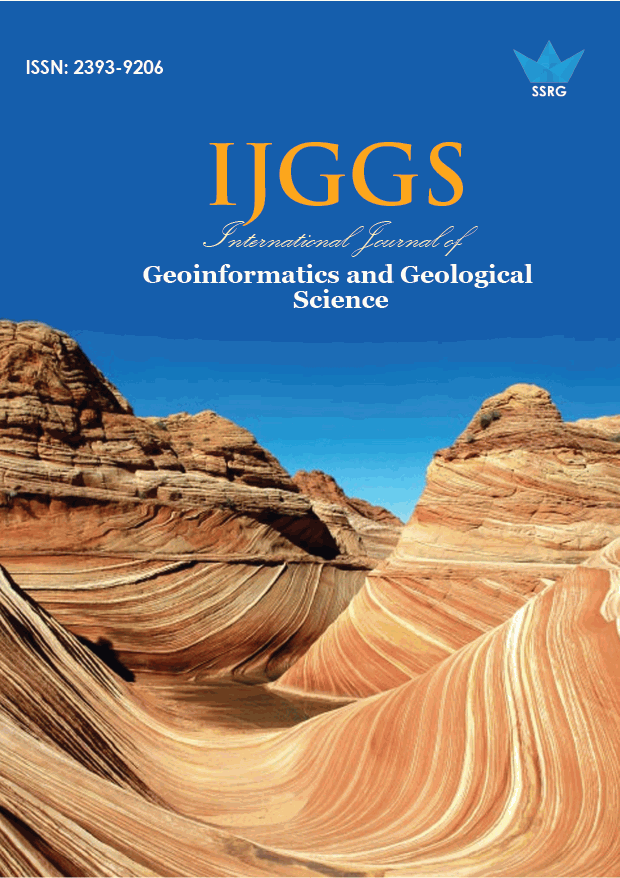Investigation of Geology and Hydro-geophysical Features Using Electromagnetic and Vertical Sounding Methods for Abu Zabad Area, Western Kordofan State, Sudan

| International Journal of Geoinformatics and Geological Science |
| © 2019 by SSRG - IJGGS Journal |
| Volume 6 Issue 3 |
| Year of Publication : 2019 |
| Authors : Elhag A. B, Musa M. A |
How to Cite?
Elhag A. B, Musa M. A, "Investigation of Geology and Hydro-geophysical Features Using Electromagnetic and Vertical Sounding Methods for Abu Zabad Area, Western Kordofan State, Sudan," SSRG International Journal of Geoinformatics and Geological Science, vol. 6, no. 3, pp. 18-23, 2019. Crossref, https://doi.org/10.14445/23939206/IJGGS-V6I3P103
Abstract:
The geology and hydro-geophysical features can aid in identifying borehole location. The study aims to investigate groundwater aquifers and best location of boreholes in the crystalline basement area of Abu Zabad near El Obeid Southwest, Sudan. The study area is underlain by two aquifers formations from Precambrian age. The oldest units of basement complex of area under investigation consist of metamorphic rocks including gneiss, schist, and quartzite.
The geophysical methods electromagnetic (EM) and vertical electrical sounding (VES) surveys showed that best aquifers yield for construction of boreholes are in weathering and fractures formation. The EM results revealed that structural features are significant for groundwater potential and interpretation of the VES data also revealed four geo-electric layers, but generally two distinct lithologic layers, which include Superficial deposit and bedrock-basement respectively. The curves generated from the data revealed H curve and HK curve, and thickness of these layers varies from 15 m to 50 m in the area. The aquifer thickness range from 20 m to 30 m. The study concludes that these techniques are suitable for identifying borehole location in the basement rock in Abu Zabad Area Sudan.
Keywords:
electromagnetic and geoelectric survey, aquifer units and groundwater potential.
References:
[1] Acharya, T. Biswas, A. Bhattacharyya, A. Chakraborty, A. Chakraborty, M. and Sarkar, M., (2018): Vulnerability mapping of saline water intrusion in coastal aquifers of West-Bengal, India using flow-net approach. Indian Groundwater 10, P. 46-56.
[2] Biswas, A. and Sharma, S. P., (2017): Geophysical surveys for identifying source and pathways of subsurface water inflow at the Bangur chromite mine, Odisha, India. Natural Hazards 88 (2), P. 947-964.
[3] Biswas, A. Jana, A. and Mandal, A., (2013): Application of Remote Sensing, GIS and MIF technique for Elucidation of Groundwater Potential Zones from a part of Orissa coastal tract, Eastern India. Research Journal of Recent Sciences 2 (11), P. 42-49.
[4] Biswas, A. Jana A., and Sharma S. P., (2012): Delineation of groundwater potential zones using satellite remote sensing and geographic information system techniques: a case study from Ganjam district, Orissa, India. Research Journal of Recent Sciences 1 (9), 59-66, Available online at: www.isca.in.
[5] Cardimona, S., (2017): Electrical Resistivity technique for Subsurface Investigation.
[6] Duzgoren-Aydin, N.S., Aydin, A. and Malpas, J., (2002): Distribution of clay minerals along a weathered pyroclastic profile, Hong Kong. Catena, 50, P. 17-41.
[7] Elhag A. B., (2016): Application of Remote Sensing and Geo-Electrical Method for Groundwater Exploration in Khor Al Alabyad, North Kordofan State, Sudan. American Journal of Earth Sciences. http://www.openscienceonline.com/journal/archive2? journalId=715&paperId=2914.
[8] Elhag, A. B. and Elzien, S. M., (2013): Structures Controls on Groundwater Occurrence and Flow in Crystalline Bedrocks: a case study of the El Obeid area, Western Sudan. Global Advanced Research Journal of Environmental Science and Toxicology (ISSN: 2315-5140) Vol. 2(2) p. 037-046. Available online http://garj.org/garjest/index.htm.
[9] Eltahir, A. D. M., (2018): Late Quaternary Sedimentary and Paleoclimatic Evolution of Kordofan, Sudan, Ph.D. Dissertation for the doctorate degree of the Université Grenoble Alpes, France.
[10] Gautam, P. and Biswas, A., (2016): 2D Geo-electrical imaging for shallow depth investigation in Doon Valley Sub-Himalaya, Uttarakhand, India. Modeling Earth Systems and Environment 2 (4), 175.
[11] Nejad, H. T., (2009): Geoelectrical Investigation of the Aquifer Characteristics and Groundwater Potential in Bahbadan Azad University Farm, Khuzestan province, Iran. Journal of Applied Sciences. ISSN: 1812 – 5654. 9(20); P. 3691-3698.
[12] Obiora, D. N., and Ownuka, O. S., (2005): Groundwater Exploration in Ikorodu, Lagos-Nigeria: A Surface Geophysical Survey Contribution, University of Nigeria, Nsukka. The Pacific Journal of Science and Technology, Volume 6. Number 1., p. 86 – 93, http://www.akamaiuniversity.us/PJST.htm.
[13] Parial, K. Biswas, A. Agrahari, S. Sharma, S. P., and Sengupta, D., (2015): Identification of contaminated zones using direct current resistivity surveys in and around ash ponds near Kolaghat Thermal power plant, West Bengal, India. International Journal of Geology and Earth Sciences 1 (2), P. 55-64.
[14] Rodis, H.G., Hassan, A., Wahadan, L., (1968): Groundwater Geology of Kordofan Province-Sudan, Contribution to the hydrology of Africa and Mediterranean Region. United State government printing office. Washington.
[15] Sharma, S. P. and Biswas, A., (2013): A practical solution in delineating thin conducting structures and suppression problem in direct current resistivity sounding. Journal of earth system science 122 (4), P. 1065-1080.
[16] Sharma, S. P. and Baranwal, V. C., (2005): Delineation of groundwater-bearing fracture zones in a hard rock area integrating very low frequency electromagnetic and resistivity data. Journal of Applied geophysics 57 (2), P. 155-166.
[17] Sree Devi, P. D., Srinivasulu, S. and Ragu, K. K., (2001): Hydro-geomorphological and groundwater prospects of the Pageru river basin by using remote sensing data. Environmental Geology, 40, p. 1088-1094.
[18] U.N.S Special 92 Fund (DOX - SUD - A 39) (1965): United Nations Special Fund, F.A.O Land and Water Use Survey in Kordofan Province, Sudan. Reports of the following notations:- DOX - sun – A 39.
[19] Van Daele, K., (2011): Characterization of geological materials, their weathering products and their relationship with soils in the Gilgel Gibe catchment, SW Ethiopia. Ghent University, Belgium. (published M.Sc. in geology), p. 14.
[20] Warage, A., (2007): Seismotectonice in Central Sudan and Local Site Effect in Western Khartoum, Master Thesis in Geodynamics, Department of Earth Science University of Bergen, Norway.

 10.14445/23939206/IJGGS-V6I3P103
10.14445/23939206/IJGGS-V6I3P103